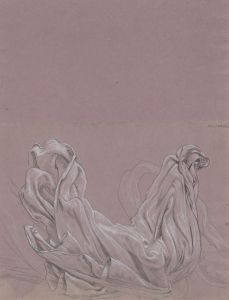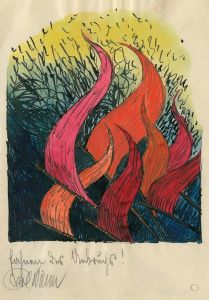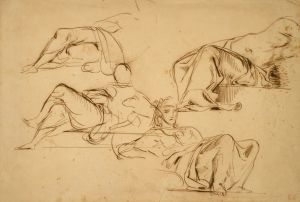
Study of Anarchy
A hand-painted replica of Elihu Vedder’s masterpiece Study of Anarchy, meticulously crafted by professional artists to capture the true essence of the original. Each piece is created with museum-quality canvas and rare mineral pigments, carefully painted by experienced artists with delicate brushstrokes and rich, layered colors to perfectly recreate the texture of the original artwork. Unlike machine-printed reproductions, this hand-painted version brings the painting to life, infused with the artist’s emotions and skill in every stroke. Whether for personal collection or home decoration, it instantly elevates the artistic atmosphere of any space.
Elihu Vedder was an American symbolist painter, known for his allegorical and often mystical works. One of his notable paintings is "Study of Anarchy," which reflects the tumultuous social and political climate of the time. Vedder's work often delved into themes of chaos and order, and "Study of Anarchy" is a prime example of his exploration of these concepts.
"Study of Anarchy" was created during a period when Vedder was deeply influenced by the social upheavals and the philosophical movements of the late 19th century. The painting is characterized by its dramatic composition and use of symbolism, which are hallmarks of Vedder's style. It captures the essence of disorder and the breakdown of societal structures, a theme that resonated with many during the era of rapid industrialization and political change.
Vedder's approach to art was heavily influenced by his time spent in Europe, particularly in Italy, where he was exposed to classical art and the burgeoning symbolist movement. This European influence is evident in "Study of Anarchy," where classical elements are juxtaposed with modern themes of chaos and disruption. The painting employs a muted color palette, which adds to the somber and contemplative mood of the piece.
The symbolism in "Study of Anarchy" is complex and open to interpretation, which is typical of Vedder's work. He often used allegorical figures to convey deeper philosophical messages. In this painting, the figures may represent various facets of society and the forces that drive it towards disorder. Vedder's use of light and shadow further enhances the dramatic tension within the composition, drawing the viewer into the chaotic world he depicts.
Elihu Vedder was part of a broader movement of artists and thinkers who were questioning the established norms and exploring new ideas about society and the individual. His work, including "Study of Anarchy," reflects a deep engagement with the philosophical and existential questions of his time. Vedder's paintings often invite viewers to reflect on the nature of humanity and the forces that shape our world.
"Study of Anarchy" remains an important work in Vedder's oeuvre, illustrating his unique ability to blend classical techniques with modern themes. It stands as a testament to his skill as a painter and his insight as a thinker. While not as widely known as some of his other works, "Study of Anarchy" continues to be appreciated for its artistic and intellectual depth.
Overall, Elihu Vedder's "Study of Anarchy" is a compelling exploration of the themes of chaos and order, rendered with the artist's characteristic symbolic style. It captures a moment in history when society was grappling with profound changes, and it remains relevant as a reflection on the enduring questions of human existence.


















